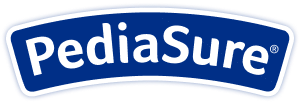Every shake has protein, vitamins A & D, and zinc, as well vitamins C & E and selenium, which are antioxidants that are essential to immune function. All 7 of these nutrients support immune systems. Here’s how some benefit your kiddo:
Key nutrients for immune support
VITAMIN C
Supports the immune system, bone formation, and iron absorption
Where to find it: Strawberries, pineapples, tangerines, broccoli, cauliflower, and peppers
Amount per serving of PediaSure: 23mg (25% Daily Value), as much vitamin C as ½ cup of raspberries†
Listed on the label as: Ascorbic Acid
VITAMIN E
Helps maintain a healthy nervous system and aids developing cells
Where to find it: Vegetable oils, nuts, seeds, and leafy, green vegetables
Amount per serving of PediaSure: 3mg (20% Daily Value), as much vitamin E as ½ cup of cooked spinach†
Listed on the label as: dl-Alpha-Tocopheryl Acetate
SELENIUM
Is an antioxidant that supports immune system cells
Where to find it: Tuna, Brazil nuts, meat, poultry, beans, mushrooms, and sunflower seeds
Amount per serving of PediaSure: 8mcg (15% Daily Value)
Listed on the label as: Sodium Selenate
ZINC
Supports immune function and healthy growth and development
Where to find it: Red meat, poultry, baked beans, chickpeas, nuts, and pumpkin seeds
Amount per serving of PediaSure: 1.7mg (15% Daily Value)
Listed on the label as: Zinc Sulfate
Essential nutrients for muscle and bone growth
Strong bones and muscles support kids’ bodies and help them keep moving.
PROTEIN
Helps build bones, muscles, and skin and plays a vital role in growth and many bodily functions
Where to find it: Meat, eggs, beans, milk, Greek yogurt, cottage cheese, and nut butters
Amount per serving of PediaSure: 7g (14% Daily Value)
Listed on the label as: Milk Protein Concentrate and Soy Protein Isolate
CALCIUM
Helps build bones and keep them strong
Where to find it: Dairy foods and green, leafy vegetables
Amount per serving of PediaSure: 330mg (25% Daily Value), as much as ½ cup of yogurt†
Listed on the label as: Calcium Phosphate, Calcium Carbonate, and Calcium Pantothenate
VITAMIN D
Helps with the formation of bones and teeth
Where to find it: Salmon, tuna, fortified dairy products. It’s also synthesized by the skin when exposed to sunlight.
Amount per serving of PediaSure: 6mcg (30% Daily Value), as much as 2 cups of vitamin D-fortified milk†
Listed on the label as: Vitamin D3
Nutrients that nourish the brain and eyes
The brain controls everyone’s ability to think, remember, feel, see, hear, talk, move, and more.
DHA OMEGA-3
Feeds the brain and helps it function properly
Where to find it: Salmon, trout, seafood, walnuts, almonds, cashews, and pistachios
Amount per serving of PediaSure: 32mg
Listed on the label as: Tuna Oil
LUTEIN
Supports eye health
Where to find it: Eggs, green beans, kale, spinach, broccoli, romaine, kiwi, and grapes
Amount per serving of PediaSure: 500mcg
Listed on the label as: Lutein
CHOLINE
Supports brain function and development
Where to find it: Eggs, mushrooms, brussels sprouts, and meats like beef and liver
Amount per serving of PediaSure: 80mg (15% Daily Value)
Listed on the label as: Choline Chloride
† Nutrition information sourced from USDA FoodData Central, fdc.nal.usda.gov. Accessed November 30, 2020.






CONNECT WITH US